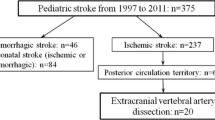Abstract
Spontaneous dissection of the vertebral artery (VA) is usually managed medically. The objective of this report was to describe 10 patients treated surgically for spontaneous dissection of the VA. Seven men and three women with a mean age of 52.5 ± 11.3 years were treated between December 1978 and January 2001. In eight cases the presenting symptom was neck pain. Transient ischemic attack or completed stroke in the vertebrobasilar distribution followed in nine cases. In the remaining case, symptoms resulted from irritation of the superior roots of the brachial plexus. Dissection was located in one segment of the VA in seven cases and two contiguous segments in three cases. Lesions involved aneurysm in seven cases, tight stenosis in two, and occlusion in one. The decision to perform surgery was made because of either continued symptoms despite maximal anticoagulation therapy or the presence of an aneurysm causing recurrent thromboembolism or threatening rupture. In eight cases the revascularization procedure consisted of bypass from the carotid artery to the distal VA. In the remaining two cases revascularization was achieved by transposition of the VA directly onto the common or internal carotid artery. Postoperative recovery was uneventful in all cases. No further neurological events were observed in any patient at a mean follow-up of 96.9 ± 66 months (range, 12-216 months). Long-term resolution of vertebrobasilar symptoms was achieved in all cases, including one patient whose bypass occluded at 6 months. From these results we conclude that surgical treatment is the method of choice for spontaneous dissection of the extracranial VA associated with continued vertebrobasilar symptoms despite maximal medical therapy or with an expanding aneurysm. The most useful technique is bypass to the distal VA. Morbidity is low and long-term outcome is excellent.



Similar content being viewed by others
References
E Josien (1992) ArticleTitleExtracranial vertebral artery dissection: nine cases J Neurol 239 327–330 Occurrence Handle10.1007/BF00867589 Occurrence Handle1512608 Occurrence Handle1:STN:280:DyaK38zotFGnsA%3D%3D
LR Caplan CK Zarins M Hemmati (1985) ArticleTitleSpontaneous dissection of the extracranial vertebral arteries Stroke 16 1030–1038 Occurrence Handle1:STN:280:DyaL287itl2hsw%3D%3D Occurrence Handle4089921
B Mokri (1997) Spontaneous dissections of cervicocephalic arteries KMA Welch LR Caplan DJ Reis BK Siesjö B Weir (Eds) Primer on Cerebrovascular Diseases Academic Press San Diego 390–396
WI Schievink (2001) ArticleTitleSpontaneous dissection of the carotid and vertebral arteries N Engl J Med 344 898–906 Occurrence Handle10.1056/NEJM200103223441206 Occurrence Handle1:STN:280:DC%2BD3M7nsV2ltQ%3D%3D Occurrence Handle11259724
K Nakagawa H Touho T Morisako et al. (2000) ArticleTitleLong-term follow-up study of unruptured vertebral artery dissection: clinical outcomes and serial angiographic findings J Neurosurg 93 19–25 Occurrence Handle10883900 Occurrence Handle1:STN:280:DC%2BD3czjvV2muw%3D%3D
E Touzé B Randoux E Méary C Arquizan JF Meder JL Mas (2001) ArticleTitleAneurysmal forms of cervical artery dissection. Associated factors and outcome Stroke 32 418–423 Occurrence Handle11157176
A Sommer W Neff A Schwartz (1998) ArticleTitleSpontaneous healing of cervical pseudoaneurysm in vertebral artery dissection under anticoagulant therapy Neuroradiology 40 249–251 Occurrence Handle10.1007/s002340050577 Occurrence Handle9592797 Occurrence Handle1:STN:280:DyaK1c3lsFWmtw%3D%3D
J Chiras S Marciano J Vega Molina B Poirier J Bories (1985) ArticleTitleSpontaneous dissecting aneurysm of the extracranial vertebral artery Neuroradiology 27 327–333 Occurrence Handle10.1007/BF00339566 Occurrence Handle4047389 Occurrence Handle1:STN:280:DyaL28%2FhsVygtA%3D%3D
Y Ito R Ishii Y Suzuki M Kikuoka K Hirano S Kodama (1988) ArticleTitleRuptured dissecting aneurysm of the vertebral artery revealed by repeat angiography Neurosurgery 23 225–227 Occurrence Handle3185882 Occurrence Handle1:STN:280:DyaL1M%2FktVGitg%3D%3D
AJ Chang E Mylonakis P Karanasias DF Orchis ParticleDe R Gold (1999) ArticleTitleSpontaneous bilateral vertebral artery dissections: case report and literature review Mayo Clin Proc 74 893–896 Occurrence Handle10.4065/74.9.893 Occurrence Handle10488791 Occurrence Handle1:STN:280:DyaK1Mvhs1yqtg%3D%3D
JL Mas MG Bousser D Hasboun D Laplane (1987) ArticleTitleExtracranial vertebral artery dissections: a review of 13 cases Stroke 18 1037–1047 Occurrence Handle3318002 Occurrence Handle1:STN:280:DyaL1c%2FntFGmsw%3D%3D
D Leys C Lucas M Gobert G Deklunder JP Pruvo (1997) ArticleTitleCervical artery dissections Eur Neurol 37 3–12 Occurrence Handle1:STN:280:DyaK2s7ntVOhsw%3D%3D Occurrence Handle9018025
E Kieffer B Praquin L Chiche F Koskas A Bahnini (2002) ArticleTitleDistal vertebral artery reconstruction: long-term outcome J Vasc Surg 36 549–554 Occurrence Handle10.1067/mva.2002.126092 Occurrence Handle12218980
G Redekop K TerBrugge R Willinsky (1999) ArticleTitleSubarachnoid hemorrhage from vertebrobasilar dissecting aneurysm treated with staged bilateral vertebral artery occlusion: the importance of early follow-up angiography: technical case report Neurosurgery 45 1258–1263 Occurrence Handle10.1097/00006123-199911000-00056 Occurrence Handle10549948 Occurrence Handle1:STN:280:DC%2BD3c%2Fhs1Wnsw%3D%3D
T Tsukahara H Wada K Satake H Yaoita A Takahashi (1995) ArticleTitleProximal balloon occlusion for dissecting vertebral aneurysms accompanied by subarachnoid hemorrhage Neurosurgery 36 914–920 Occurrence Handle7791981 Occurrence Handle1:STN:280:DyaK2Mzht1Wqtg%3D%3D
H Hugenholtz R Pokrupa VJ Montpetit R Nelson MT Richard (1982) ArticleTitleSpontaneous dissecting aneurysm of the extracranial vertebral artery Neurosurgery 10 96–100 Occurrence Handle7057985 Occurrence Handle1:STN:280:DyaL387isFOktw%3D%3D
Author information
Authors and Affiliations
Corresponding author
About this article
Cite this article
Chiche, L., Praquin, B., Koskas, F. et al. Spontaneous Dissection of the Extracranial Vertebral Artery: Indications and Long-Term Outcome of Surgical Treatment. Ann Vasc Surg 19, 5–10 (2005). https://doi.org/10.1007/s10016-004-0149-8
Published:
Issue Date:
DOI: https://doi.org/10.1007/s10016-004-0149-8




